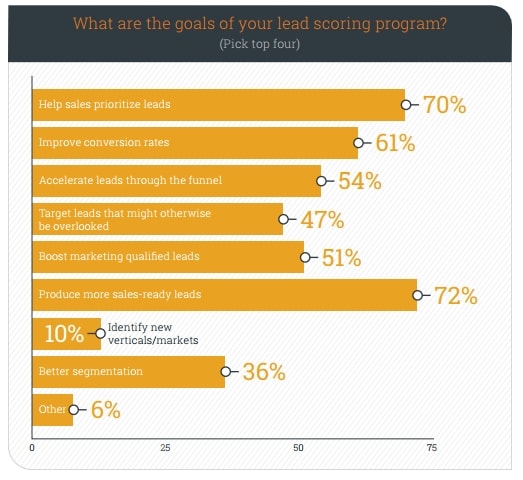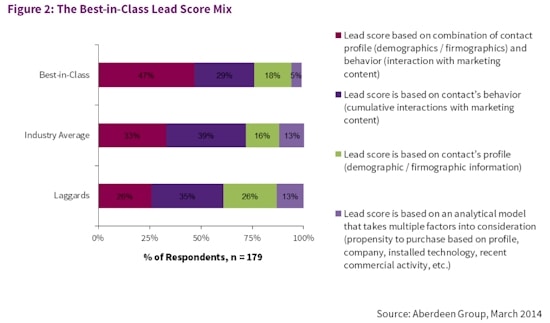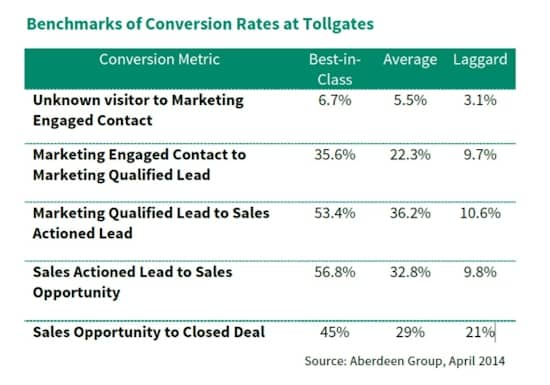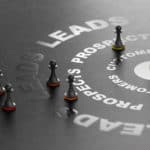Winnowing the leads your marketing process collects is an important task. Which downloaders, event and webinar attendees, email contacts should your sales team put at the top of it’s list and which should the marketing automation system take care of? Lead Scoring helps you prioritise those leads. It is an important element of the lead nurturing process and critical input to your lead qualification system.
In this post I dive into a practical approach to lead scoring you can get up and running quickly.
- What is Lead Scoring
- A Simple Lead Scoring Example
- Why You Should Score Your Leads
- How You Should Not use it
- Lead scoring Vs Lead qualification
- Lead Scoring Best Practices
- How Many Leads Should Get Through
- Before You Start
- Getting Started in your Scoring system
- Attributes that Increase Lead Score
- Attributes that Reduce Lead Score
- Attributes that Don't change Lead Score
- Putting it all Together
What is Lead Scoring
Lead Scoring is the process of assessing prospects, against a set of standard criteria, to estimate sales potential and sales timing. It is an important part of the lead qualification process and is typically used to determine when (and whether) to assign a specific prospect to a sales person for direct action, a so-called SQL (Sales Qualified Lead).
A Simple Lead Scoring Example
Imagine for a moment you’re a plumber. You decide to set up a simple process to qualify your sales opportunities and score your leads like this:
- Prospect is within 20kms of your base location: +50 points
- Prospect is greater than 50km from your base: -100 points
- Prospect is a property management businesses (and might offer large long-term contracts): +50 points.
- Residential prospects who want repairs: +20 points
- Residential prospect who are building a new house (a bigger opportunity): +50 points
- Prospects referred by existing customers: +50 points
In this example, a residential prospect, building a new house 15 kms away, would score +100 points.
Now you can score each sales lead and prioritise how much effort you should invest to close the sale.
Why You Should Score Your Leads
Scoring your leads helps to allocate scarce sales resources to the most likely sales opportunities and not waste time on leads that are unlikely to ever convert to customers.
There are several benefits to adding it to your lead qualification process
Sales and marketing working together
Sales and marketing can explicitly agree which leads are the best opportunities – getting an agreement means they are more likely to work together.
Sales are less likely to complain about the leads they are provided as they have a role in deciding which leads they receive.
Track and improve
Formulating the score in this way means you can continuously improve the scoring process. Tracking how many qualified leads turn into sales and how many unqualified leads still convert to sales helps you to understand what is important. Then you can tweak the scoring structure over time to improve it.
Lift sales staff trust (and drive action) in leads provided to them
According to a Gartner study, 70% of leads are lost from poor sales follow-up. Using this process to improve the quality, and rank, leads improves the hit rates and trust of sales in the leads provided to them
It’s a primary driver of revenue
68% of Efficient and effective marketers report using lead scoring as a primary driver of their revenue contribution (The Lenskold and Pedowitz Groups)
How You Should Not use it
To answer the reverse question check out this research from DemandGen.
In it marketers are asked why they are scoring leads and it has, I think, some unhelpful perceptions.
Producing more sales ready leads (the highest response) is, I would argue, the reverse of good scoring. Also, accelerating leads through the funnel and boosting marketing qualified leads are looking at the problem the wrong way around.
In practice you should be looking to help sales prioritize the leads they have, not push more through. If you don’t have enough leads you should first focus on generating more leads.

Lead scoring Vs Lead qualification
These two ideas can be confused, but scoring is just a sub-set of lead qualification. You use the lead score in the lead qualification process.
Lead Scoring Best Practices
In 2004 Aberdeen Group delivered a report (Lead Scoring: The fundamentals and factors in best-in-class programs Aberdeen Group 2014) examining what Best In Class organisations were doing that Laggards were not.

The chart shows Best-In-Class organisations focused on two simple factors
- Contact profile – firmographics and demographics; and
- Interaction with marketing content
Whereas Laggards spent more time on
- Analytical models that considered multiple attributes.
This shows contact profile and interaction are the two key drivers of a good lead score process. I think it also probably indicates a focus on action through simple implementation rather than complexity.
Adding this to our own experience in B2B marketing the best practices in lead scoring are:
- Buyer Personas should drive a large part of the score: the right persona is critical in B2B sales
- Company Firmographics should drive a large part of the score: no matter how right the persona, if the company is wrong, the score is low.
- Marketing content interaction is an excellent way of determine when the right lead is ready to buy
- Start simple and build complexity – Typically there are just a few key attributes in the score so start simple and only build out based on evidence.
- Use real world data – use data from previous sales to drive scores, not intuition or gut feel.
How Many Leads Should Get Through
So how many leads should you let through? Another Aberdeen report shows that Best-In-Class organizations convert more leads to sales qualified than Laggards.
In this case I think the question is wrong, not the answer.
You should not be seeking to adjust your lead score to let as high a proportion as possible through. Instead you should be looking to that delicate balance between flooding sales staff with low quality leads and missing market share.

Before You Start
There are two pre-requisites you must have sorted before you build your system.
1. Buyer Persona
Define your Personas: Until you clearly understand your target Buyer Personas it is very difficult to assign any type of score.
Key Point: Scoring your Buyer Persona will tell you if you are ever likely to make a sale.

2. Buyer Journey
Define your Buyer’s Journey: The Buyers Journey helps you to identify where in the journey from awareness to purchase the prospect is sitting.
While most initial scoring models are based on cumulative activity (email opens, email clicks, number of pages viewed), buying stage is better and you should ensure you include the journey in your model
Taking actions closer to a sale event (viewing pricing pages) should have a higher score than actions early in the journey (posts answering industry questions).
Key Point: Scoring your Buyer’s Journey will tell you how soon you are likely to make a sale. Or put another way, how hot the lead is.
Getting Started in your Scoring system
Start by looking at what has worked before.
Look back over the last few months or years of won/lost/abandoned sales and identify the common characteristics of customers who bought and those that did not.
Here’s the process we undertook a few years ago:
- We downloaded from our CRM, a list of every sales process we had been through in the past 3 years into an Excel spreadsheet
- Then we created a column for all of the sales success attributes we could think of, even if we didn’t think they were important:
- Company size
- Industry
- B2B/B2C
- Lead source
- Level of the people with whom we spoke
- etc
- Then we scored each sale by putting a Y or N in each of the attribute columns
- Lastly, we looked at which attributes were key indicators of sales success
With that analysis we were able to identify the four factors that, if all were present, predicated an 80% chance of sales success.
We were also able to identify the three factors that predicted a 20% of sales success.
The point is, working out what predicts sales for your business does not have to be complex and will probably come down to fewer factors than you expect.
Attributes that Increase Lead Score
Let’s look at some practical types of lead scoring variables you can apply to your business.
Firmographics (Persona Focused)
With your buyer persona firmly in mind you, create a matrix of firm details that make a good fit. Typical groupings might include:
- Company size
- Revenue
- Staff
- Number of locations
- Industry
- Life cycle (start-up to mature company)
Think also about sub-groups;
- Number of marketing staff
- Number of HR staff
Demographics (Persona Focused)
In a B2B context, demographics include the person’s role and seniority in the organization
- Persona – target / non-target
- Job title
- Type of role: marketing, sales, operations, product management, etc.
- Seniority
Activity (Journey Focused)
Your B2B marketing automation system should be able to tell you which pages the person has visited on your site. Try to break these down by where the page fits in the Buyers Journey.
Hopefully you will already have categorized your site content by stage in the journey so this will be made easier.

Awareness (Problem Identification) and Consideration (Search for Solutions)
Allocate low point scores to these items. Use your marketing automation system to nurture these leads until they show signs of being in a later journey stage.
Decision (Search for Purchase)
When your prospect lands on these pages you should allocate a higher score as they are closer to the decision stage of the buyer’s journey.
Examples of pages in this stage include:
- About Us (they want to learn more about you before contacting you)
- Contact
- Pricing
- Demonstration request pages, if relevant
- Customer testimonial and case studies.
- Product or service descriptions
Activity (Action Focused)
Some of the activities your prospect undertakes on you site can indicate a higher level of interest.
For instance, if someone fills out a 10 question download registration from they are indicating a higher level of interest and propensity to purchase than someone who downloads a simple piece of content with just an email address and name.
Examples include:
- Number of relevant fields filled out in the CRM system
- Number of forms completed
- Type of forms completed — here again forms focused on the end of the buyer’s journey (price requests) should have a higher point score than those at the start of the journey.
Attributes that Reduce Lead Score
Just as some attributes should add to the lead score, some should reduce it, or even completely negate it.
Firmographics (Persona Focused)
Prospects that are definitely out of you target market should actively reduce the score:
- Companies that are too big, or too small
- Prospects out of your target geography (out of state, international)
- Prospects in the wrong industry
- Competitors
Demographics (Persona Focused)
Take points off for:
- Prospects from locations that, literally, don’t speak your language
- Prospects from job roles that don’t convert
Attributes that Don’t change Lead Score
Some attributes look like they should adjust the lead score, but really, they shouldn’t.
For instance, it is common to assign a score to a prospect opening an email or clicking on a link.
These are important metrics, but they don’t necessary adjust the lead score. It’s more helpful to use them as engagement indicators that drive the type of content you send.
Good email open rates have more to do with writing good subject lines than position in the buyer’s journey.
Similarly, great click through rates have more to do with providing targeted content, but where is that content in the buyers journey?
As metrics, these attributes help you to write better headlines and target your content more effectively but they shouldn’t necessarily change the lead score.
Remember if you’re scoring based on the pages prospects view, then you are already incorporating the content they click through to.
Putting it all Together
Discuss it between Sales and Marketing until you AGREE on which elements are important, and when a customer flips from Marketing Qualified Lead to Sales Qualified Lead.
Then update your marketing automation software to incorporate the details.
As you go about this process though — ensure that you start simple and build out.
Remember the research from the very start of this post showing that best practice companies focus on the few important indicators.



